Liquid Mixing on Falling Films: Marker-Free, Molecule-Sensitive 3D Mapping Using Raman Imaging
Abstract
1. Introduction
1.1. State of the Art
1.1.1. Local Film Thickness
1.1.2. Concentration Measurements on Trickle and Falling Films
2. Materials and Methods
2.1. Trickle Film
2.2. Raman Imaging
2.3. Laminar and Turbulent Mixing
2.4. Design of Experiments
3. Results and Discussion
3.1. Proof of Concept
3.2. Mixing on Plain Surface
3.3. Mixing on Pillow Plate
4. Conclusions
Author Contributions
Funding
Institutional Review Board Statement
Informed Consent Statement
Data Availability Statement
Conflicts of Interest
References
- Soave, G.; Feliu, J.A. Saving energy in distillation towers by feed splitting. Appl. Therm. Eng. 2002, 22, 889–896. [Google Scholar] [CrossRef]
- U.S. Energy Information Administration. Manufacturing Energy Consumption Survey (Mecs): Chemical Industry Analysis Brief. Available online: https://www.eia.gov/consumption/manufacturing/briefs/chemical/index.php (accessed on 15 November 2022).
- Alfeld, M.; Eckhardt, H.-S.; Kraft, J.; Maiwald, M.; Meermann, B.; Merz, K.; Pacholski, C.; Prikler, S.; Richert, J.; Steiner, G.; et al. Trendbericht Analytische Chemie. Nachr. Chem. 2020, 68, 52–60. [Google Scholar] [CrossRef]
- Medina, I.; Deuerling, J.; Kumari, P.; Scholl, S.; Rädle, M. Visualization of Local Concentration and Viscosity Distribution during Glycerol-Water Mixing in a Y-Shape Minichannel: A Proof-of-Concept-Study. Micromachines 2021, 12, 940. [Google Scholar] [CrossRef] [PubMed]
- Stewart, S.; Priore, R.J.; Nelson, M.P.; Treado, P.J. Raman imaging. Annu. Rev. Anal. Chem. 2012, 5, 337–360. [Google Scholar] [CrossRef] [PubMed]
- Nachtmann, M.; Feger, D.; Sold, S.; Wühler, F.; Scholl, S.; Rädle, M. Marker-Free, Molecule Sensitive Mapping of Disturbed Falling Fluid Films Using Raman Imaging. Sensors 2022, 22, 4086. [Google Scholar] [CrossRef]
- Sibai, F. Experimentelle Untersuchung der Strömungscharakteristik und des Wärmeübergangs bei Welligen Rieselfilmen. Ph.D. Thesis, RWTH Aachen University, Aachen, Germany, 2004. [Google Scholar]
- Hopf, L. Turbulenz bei einem Flusse. Ann. Phys. 1910, 337, 777–808. [Google Scholar] [CrossRef]
- Nußelt, W. Oberflächenkondensation des Wasserdampfes. VDI-Z. 60, 1916, 541-546, 569-574. Available online: https://www.scirp.org/(S(351jmbntvnsjt1aadkozje))/reference/referencespapers.aspx?referenceid=2247248 (accessed on 20 May 2023).
- Nußelt, W. Der Wärmeaustausch am Berieselungskühler. VDI-Z 67. 1923. 9. 206/216. Available online: https://d-nb.info/974308692/34 (accessed on 20 May 2023).
- Portalski, S. Studies of falling liquid film flow Film thickness on a smooth vertical plate. Chem. Eng. Sci. 1963, 18, 787–804. [Google Scholar] [CrossRef]
- Fallah, R.; Hunter, T.G.; Nash, A.W. Isothermal flow in liquid wetted wall systems. J. Soc. Chem. Ind. 1934, 53, 369–379. [Google Scholar]
- Hewitt, G.F.; Lovegrove, P.C.; Nichols, B. Film thickness measurement using fluorescence technique. Pt. 1. Description of the method. Atomic Energy Research Establishment, 1964, AERE-R 4478. Available online: https://www.filmetrics.com/?src=google&cid=English&gid=962543&key=measuring%20thin%20film&d=c&m=b&gclid=Cj0KCQjw4s-kBhDqARIsAN-ipH1lu8q1__vJxXWrriHtXQr3WFvPbwcHzzBf2o5WSb65_vGN5SAopHoaArgSEALw_wcB (accessed on 20 May 2023).
- Telles, A.S.; Dukler, A.E. Statistical Characteristics of Thin, Vertical, Wavy, Liquid Films. Ind. Eng. Chem. Fund. 1970, 9, 412–421. [Google Scholar] [CrossRef]
- Lou, W.; Kane, A.; Wolbert, D.; Rtimi, S.; Assadi, A.A. Study of a photocatalytic process for removal of antibiotics from wastewater in a falling film photoreactor: Scavenger study and process intensification feasibility. Chem. Eng. Process. Process. Intensif. 2017, 122, 213–221. [Google Scholar] [CrossRef]
- Tourvieille, J.-N.; Bornette, F.; Philippe, R.; Vandenberghe, Q.; de Bellefon, C. Mass transfer characterisation of a microstructured falling film at pilot scale. Chem. Eng. J. 2013, 227, 182–190. [Google Scholar] [CrossRef]
- Goedecke, R. (Ed.) Fluidverfahrenstechnik: Grundlagen, Methodik, Technik, Praxis; WILEY-VCH: Weinheim, Germany, 2006; ISBN 978-3-527-31198-9. [Google Scholar]
- Kraume, M. Transportvorgänge in der Verfahrenstechnik; Springer: Berlin/Heidelberg, Germany, 2012; ISBN 978-3-642-25148-1. [Google Scholar]
- Wakil Shahzad, M.; Burhan, M.; Choon Ng, K. Design of Industrial Falling Film Evaporators. In Heat and Mass Transfer—Advances in Science and Technology Applications; Iranzo, A., Ed.; IntechOpen: London, UK, 2019; ISBN 978-1-78984-446-7. [Google Scholar]
- Palen, J.W.; Wang, Q.; Chen, J.C. Falling film evaporation of binary mixtures. AIChE J. 1994, 40, 207–214. [Google Scholar] [CrossRef]
- Wiegand, J. Falling-film evaporators and their applications in the food industry. J. Appl. Chem. 1971, 21, 351–358. [Google Scholar] [CrossRef]
- Raman, C.V. A Change of Wave-length in Light Scattering. Nature 1928, 121, 619. [Google Scholar] [CrossRef]
- Pudlas, M. Nicht Invasive Diagnostik in der Regenerativen Medizin Mittels Raman-Spektroskopie; (Nicht für den Austausch); Fraunhofer Verlag: Stuttgart, Germany, 2012; ISBN 978-3-8396-0396-3. [Google Scholar]
- Raman, C.V. Part II—The Raman effect. Investigation of molecular structure by light scattering. Trans. Faraday Soc. 1929, 25, 781–792. [Google Scholar] [CrossRef]
- Raman, C.V. A new radiation. Proc. Indian Acad. Sci. 1953, 37, 333–341. [Google Scholar] [CrossRef]
- Chalmers, J.M.; Griffiths, P.R. Handbook of Vibrational Spectroscopy; Wiley: Chichester, UK, 2002; ISBN 9780471988472. [Google Scholar]
- Bumbrah, G.S.; Sharma, R.M. Raman spectroscopy—Basic principle, instrumentation and selected applications for the characterization of drugs of abuse. Egypt. J. Forensic Sci. 2016, 6, 209–215. [Google Scholar] [CrossRef]
- Smith, E. Modern Raman Spectroscopy: A Practical Approach; J. Wiley: Hoboken, NJ, USA, 2005; ISBN 0471496685. [Google Scholar]
- Szymanski, H.A. (Ed.) Raman Spectroscopy: Theory and Practice; Springer: Boston, MA, USA, 1967; ISBN 1468430262. [Google Scholar]
- Landsberg, G.S.; Mandelstam, L.I. Eine neue Erscheinung bei der Lichtzerstreuung in Krystallen. Naturwissenschaften 1928, 16, 557–558. [Google Scholar] [CrossRef]
- Lewis, I.R.; Edwards, H. Handbook of Raman Spectroscopy; CRC Press: Boca Raton, FL, USA, 2001; ISBN 9781420029253. [Google Scholar]
- Piper, M.; Olenberg, A.; Tran, J.M.; Goedecke, R.; Scholl, S.; Kenig, E. Bestimmung charakteristischer Geometrieparameter von Thermoblech-Wärmeübertragern. Chem. Ing. Tech. 2014, 86, 1214–1222. [Google Scholar] [CrossRef]
- Whitaker, D.A.; Hayes, K. A simple algorithm for despiking Raman spectra. Chemom. Intell. Lab. Syst. 2018, 179, 82–84. [Google Scholar] [CrossRef]
- He, S.; Zhang, W.; Liu, L.; Huang, Y.; He, J.; Xie, W.; Wu, P.; Du, C. Baseline correction for Raman spectra using an improved asymmetric least squares method. Anal. Methods 2014, 6, 4402–4407. [Google Scholar] [CrossRef]
- Savitzky, A.; Golay, M.J.E. Smoothing and Differentiation of Data by Simplified Least Squares Procedures. Anal. Chem. 1964, 36, 1627–1639. [Google Scholar] [CrossRef]


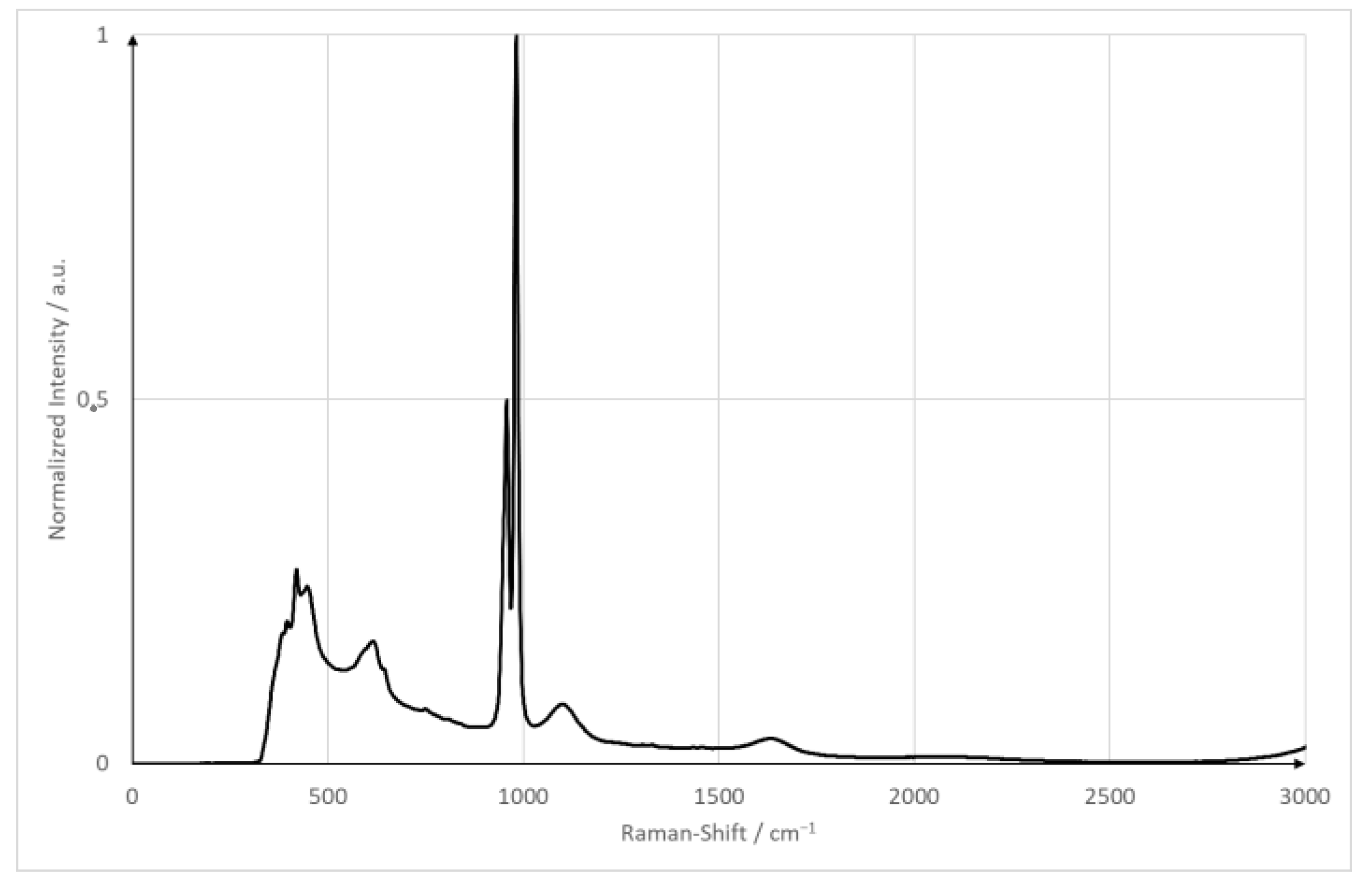
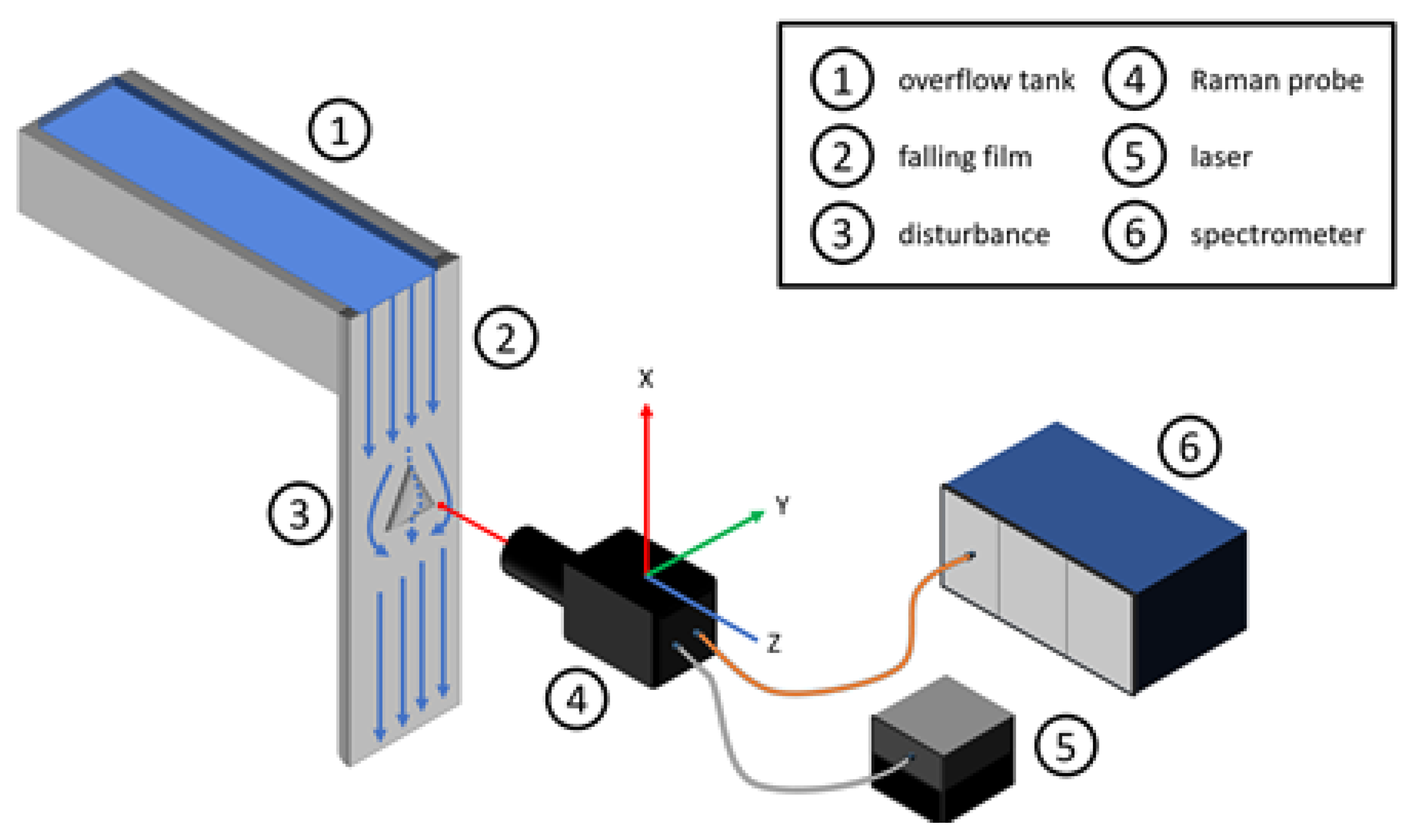
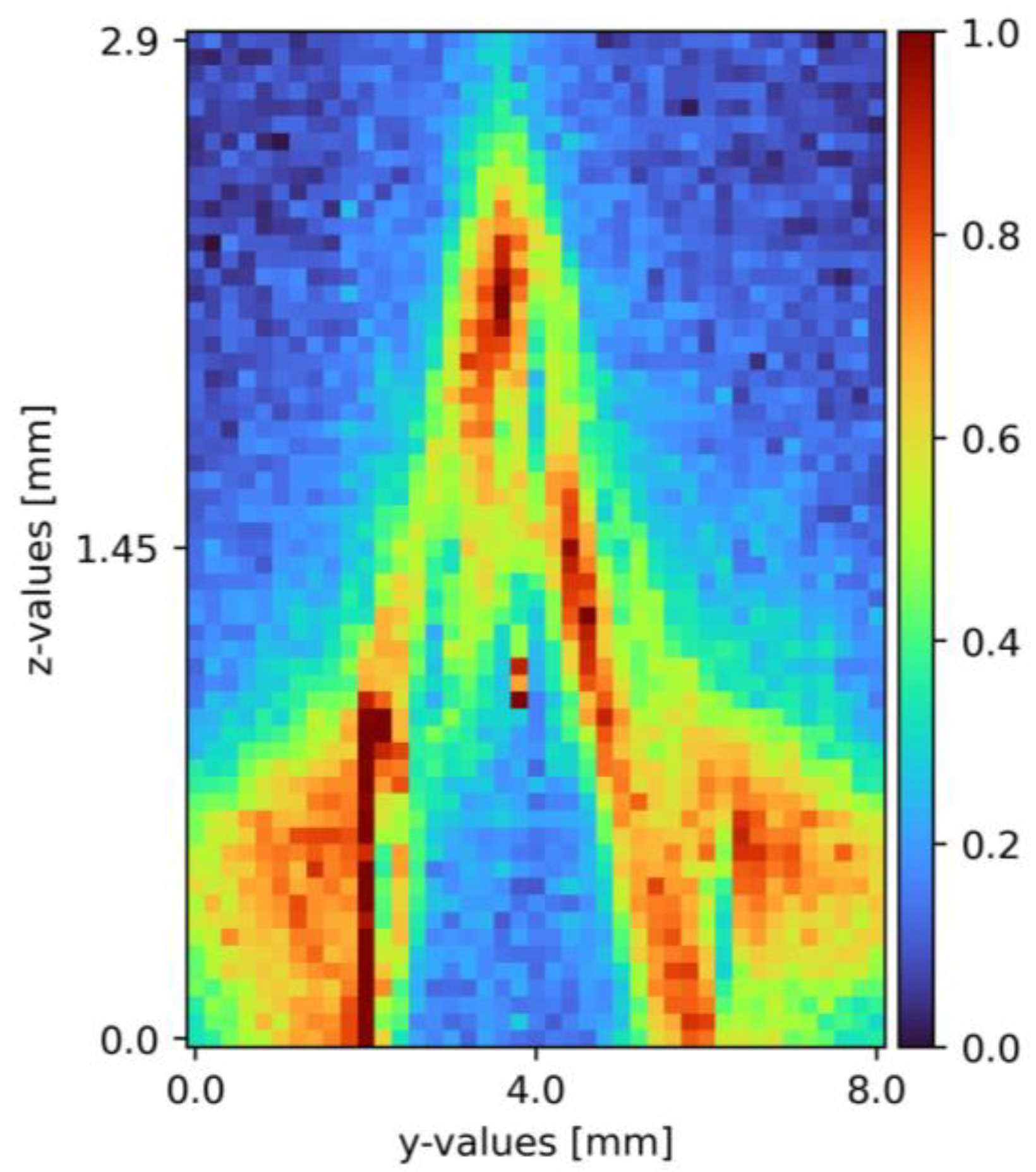
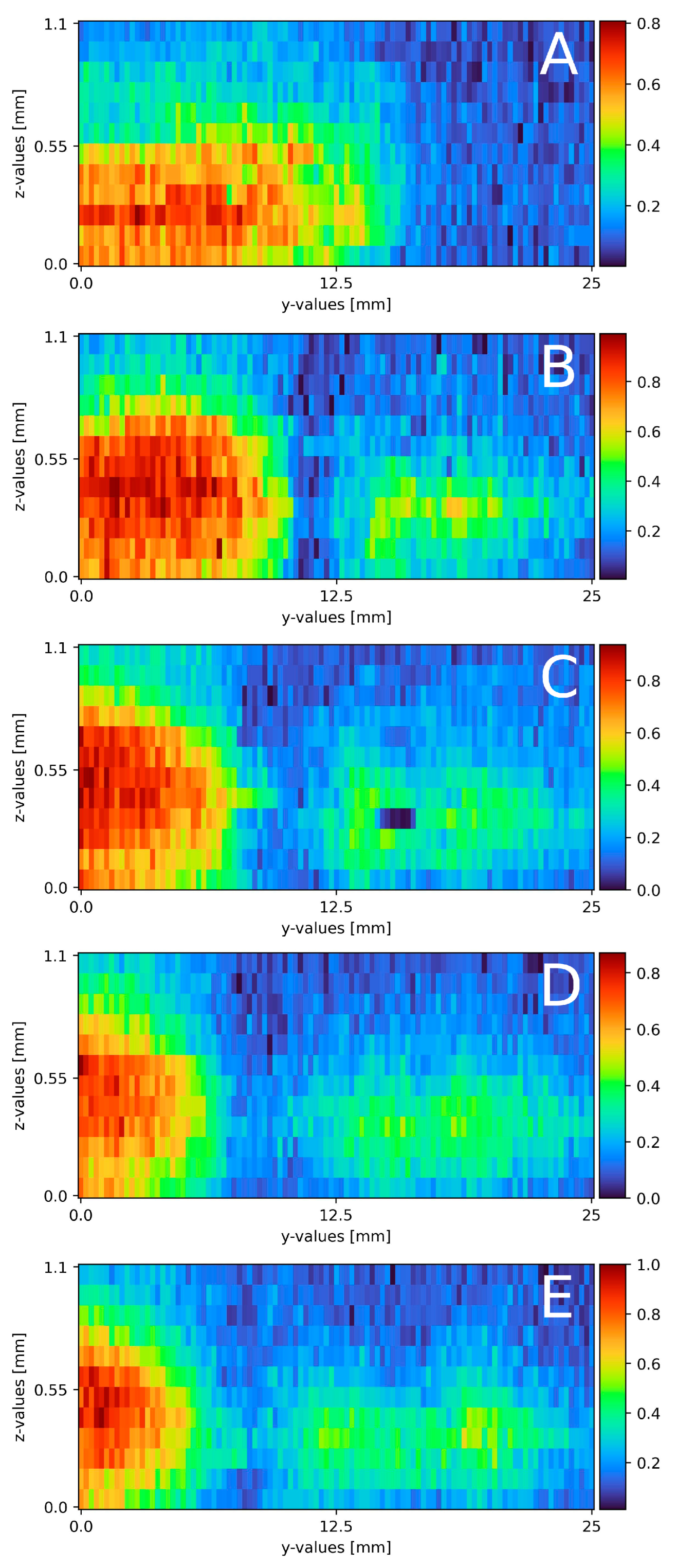
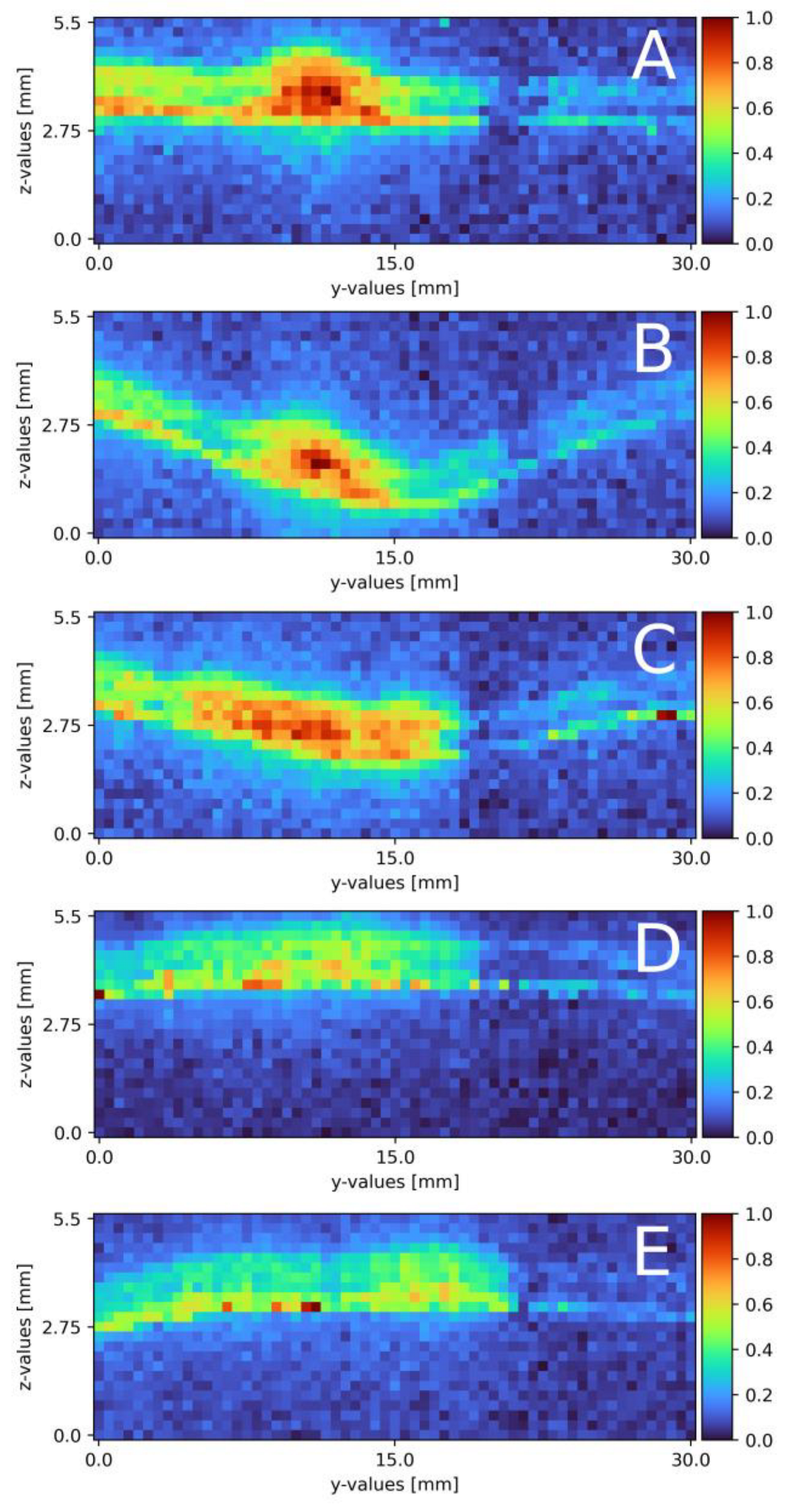
| Plant Component | Parameter | Value |
|---|---|---|
| Falling film surface | x | 600 mm |
| y | 100 mm | |
| Minimum wetting density | (pillow plate) | |
| Calculated film thickness | 0.43 mm | |
| Average pillow size | x | 35 mm |
| y | 35 mm | |
| z | 3 mm | |
| Pump | Type | rotary vane |
| Maximum flowrate (each) | 150 L/h | |
| Maximum power outlet (each) | 550 W |
| Optical Component | Parameter | Value |
|---|---|---|
| Raman spectrometer | Wavelength | 785 nm |
| Optical range | 320–3200 cm−1 | |
| Optical resolution | 5 cm−1 | |
| Laser source | Wavelength | 785 nm |
| Power | 130 mW | |
| Optical coupling | Single-mode coupling | |
| Raman probe | Focal point | 5.06 µm |
| Depth of focus | 75 µm | |
| Working distance | 16 mm | |
| Type | Co-axial |
| System | Parameter | Value |
|---|---|---|
| Optics | Integration time | 5 s |
| Accumulation | 2 | |
| Liquid | Sodium sulfate | 1 Mol/L |
| Water | 50 L | |
| Flow rate (each) | 45 L/h (plain) 66.5 L/h (pillow plate) | |
| Temperature | 20 °C |
| Surface | Axis | Distance | Step Size |
|---|---|---|---|
| plain | X | 140 mm | 35 mm |
| Y | 25 mm | 0.25 mm | |
| Z | 1.8 mm | 0.1 mm | |
| Pillow plate | X | 40 mm | 10 mm |
| Y | 35 mm | 0.5 mm | |
| Z | 5.5 mm | 0.25 mm |
Disclaimer/Publisher’s Note: The statements, opinions and data contained in all publications are solely those of the individual author(s) and contributor(s) and not of MDPI and/or the editor(s). MDPI and/or the editor(s) disclaim responsibility for any injury to people or property resulting from any ideas, methods, instructions or products referred to in the content. |
© 2023 by the authors. Licensee MDPI, Basel, Switzerland. This article is an open access article distributed under the terms and conditions of the Creative Commons Attribution (CC BY) license (https://creativecommons.org/licenses/by/4.0/).
Share and Cite
Nachtmann, M.; Feger, D.; Wühler, F.; Rädle, M.; Scholl, S. Liquid Mixing on Falling Films: Marker-Free, Molecule-Sensitive 3D Mapping Using Raman Imaging. Sensors 2023, 23, 5846. https://doi.org/10.3390/s23135846
Nachtmann M, Feger D, Wühler F, Rädle M, Scholl S. Liquid Mixing on Falling Films: Marker-Free, Molecule-Sensitive 3D Mapping Using Raman Imaging. Sensors. 2023; 23(13):5846. https://doi.org/10.3390/s23135846
Chicago/Turabian StyleNachtmann, Marcel, Daniel Feger, Felix Wühler, Matthias Rädle, and Stephan Scholl. 2023. "Liquid Mixing on Falling Films: Marker-Free, Molecule-Sensitive 3D Mapping Using Raman Imaging" Sensors 23, no. 13: 5846. https://doi.org/10.3390/s23135846
APA StyleNachtmann, M., Feger, D., Wühler, F., Rädle, M., & Scholl, S. (2023). Liquid Mixing on Falling Films: Marker-Free, Molecule-Sensitive 3D Mapping Using Raman Imaging. Sensors, 23(13), 5846. https://doi.org/10.3390/s23135846







